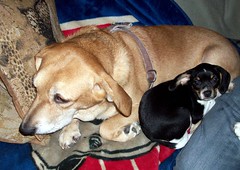Dog, Inc.
How a Collection of Visionaries, Rebels, Eccentrics, and Their Pets Launched the Commercial Dog Cloning Industry
by John Woestendiek
Paperback: 320 pages
Publisher: Avery Trade(January 3, 2012)
Dog, Inc. is not your average puppy story. Dog, Inc. chronicles the unique lengths some dog owners go to duplicate their beloved pets. Pulitzer prize-winning journalist, John Woestendiek, unravels the controversial scientific conundrum that has captured the attention of dog owners and scientists alike by revealing remarkably true stories of cloning adventures and misfires and the awkwardly ambitious humans behind them.
I will admit that I personally have not read any of Dog, Inc. yet and am not sure if I will or will not. My dogs mean the world to me... they each have their own personalities and quirks that make them so very special and unique and I'd love to have them in my life forever, but I'm not sure cloning is the answer.... or is it? What are your thoughts on the possibility of cloning your beloved furbabies?
The following is an excerpt from Dog, Inc.
Prologue
You might as well know it all right now. Lassie will not be meetin’ you after school anymore.
- Lassie Come Home (film)
HOUSTON, TEXAS
1967
It didn’t matter if she was in a movie or a TV show; if the obstacles were raging river, forest fire, mountain range, or angry bear: Lassie always came home.
One day Tippy didn’t.
On my birthday, in 1958, Tippy was my gift, a collie named for the white spot at the end of his tail—not a mirror image of the famous (to baby boomers, anyway) TV dog, but close enough for a five-year-old.
Unlike Lassie—the collie whose courage and loyalty were reincarnated in seven movies before starting a twenty-year run as an American TV show—Tippy never saved anyone stuck in a well. But, when he wasn’t roaming the neighborhood, he did help my brother and me through childhood, frequent relocation, and our parents’ divorce. When Dad left, Tippy stayed. When President Kennedy was shot and killed, Tippy was there to lean and cry on. An assassinated president may have served as my first long-distance lesson in mortality. But the demise of Tippy, my first dog, a few years later, brought death home.
That’s one of the things dogs do for us. Often, as children, we learn through them that there’s a limit to life—in their case, a very short one. What we’re often slower to learn is how to accept that and fully celebrate them during the ten or fifteen years they’re around. They come and go with class, while we—sometimes visibly, sometimes invisibly—fall apart at the seams.
When Tippy died, there were no such things as dog-loss support groups or dog bereavement counseling; people would have laughed at the very idea. There were few books on how to cope with your dog’s death, few alternatives for disposing of the corpse, no websites on which to pay tribute to a dog that had passed. There were no agencies to guide one through the grief, and few companies, at the time, seeking to exploit it.
In the 1960s, when your dog died, you shed your tears in private and moved on, or at least pretended to.
Reprinted from Dog, INC. by John Woestendiek by arrangement with Avery Books, a member of Penguin Group (USA) Inc., Copyright © 2012 by John Woestendiek.
 Happy Ten on Tuesday! Today's topic is 10 Favorite Superbowl Party Foods, so here we go...
Happy Ten on Tuesday! Today's topic is 10 Favorite Superbowl Party Foods, so here we go... 









































































